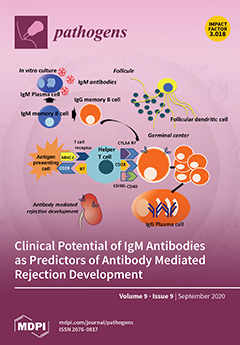Streptomyces scabies is a Gram-positive bacterial pathogen that causes common scab disease to several crops, particularly in the potato. It is a soil borne pathogen, a very devastating scab pathogen and difficult to manage in the field.
Streptomyces has several species that cause
[...] Read more.
Streptomyces scabies is a Gram-positive bacterial pathogen that causes common scab disease to several crops, particularly in the potato. It is a soil borne pathogen, a very devastating scab pathogen and difficult to manage in the field.
Streptomyces has several species that cause common scab such as
S. scabiei, S. acidiscabies, S. europaeiscabiei, S. luridiscabiei, S. niveiscabiei, S. puniciscabiei, S. reticuliscabiei, S. stelliscabiei, S. turgidiscabies,
S. ipomoeae. Common scab disease harmfully affects potato economic and market value due to the presence of black spots on the tuber. Owing to its genetic diversity and pathogenicity, the determination of pathogen presence in potato fields is still challenging. In this study,
S. scabies genetic diversity was measured by surveying five potato-growing areas of Pakistan during the growing season 2019. A total of 50
Streptomyces isolates, including
S. scabies,
S. acidiscabies,
S. griseoflavus were isolated and identified based on morphologic, biochemical and molecular analysis. Virulent confirmation assays confirmed ten virulent strains of
Streptomyces spp. On the potato cultivars Cardinal and Santee. Among the
Streptomyces species,
S. scabies showed the highest scab index, followed by
S. acidiscabies and
S. griseoflavus by exhibiting the scab-like lesions on potato tubers. Ten potato cultivars were screened against these virulent isolates of
Streptomyces. The Faisalabad white variety showed the highest scab index followed By Cardinal, Tourag, Kuroda, Santee, Lady Rosetta, Asterix, Diamant, Faisalabad red and Sadaf. Moreover, genetic diversity and pathogenicity of
Streptomyces spp. on potato tubers were also likely diverse in different geographical regions and also potato cultivars. This study represents a contribution to understanding the local interaction between potatoes and
Streptomyces spp. in Pakistan. It will aid in supporting a solution for the management of this pathogen around the world.
Full article






